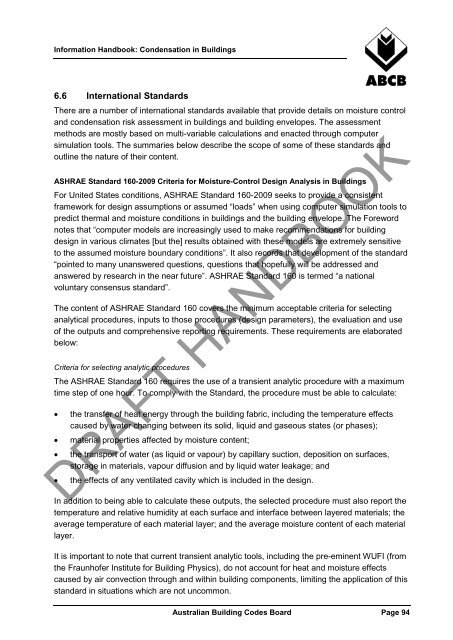Condensation in Buildings - Australian Building Codes Board
Condensation in Buildings - Australian Building Codes Board
Condensation in Buildings - Australian Building Codes Board
You also want an ePaper? Increase the reach of your titles
YUMPU automatically turns print PDFs into web optimized ePapers that Google loves.
Information Handbook: <strong>Condensation</strong> <strong>in</strong> Build<strong>in</strong>gs<br />
6.6 International Standards<br />
There are a number of <strong>in</strong>ternational standards available that provide details on moisture control<br />
and condensation risk assessment <strong>in</strong> build<strong>in</strong>gs and build<strong>in</strong>g envelopes. The assessment<br />
methods are mostly based on multi-variable calculations and enacted through computer<br />
simulation tools. The summaries below describe the scope of some of these standards and<br />
outl<strong>in</strong>e the nature of their content.<br />
ASHRAE Standard 160-2009 Criteria for Moisture-Control Design Analysis <strong>in</strong> Build<strong>in</strong>gs<br />
For United States conditions, ASHRAE Standard 160-2009 seeks to provide a consistent<br />
framework for design assumptions or assumed “loads” when us<strong>in</strong>g computer simulation tools to<br />
predict thermal and moisture conditions <strong>in</strong> build<strong>in</strong>gs and the build<strong>in</strong>g envelope. The Foreword<br />
notes that “computer models are <strong>in</strong>creas<strong>in</strong>gly used to make recommendations for build<strong>in</strong>g<br />
design <strong>in</strong> various climates [but the] results obta<strong>in</strong>ed with these models are extremely sensitive<br />
to the assumed moisture boundary conditions”. It also records that development of the standard<br />
“po<strong>in</strong>ted to many unanswered questions, questions that hopefully will be addressed and<br />
answered by research <strong>in</strong> the near future”. ASHRAE Standard 160 is termed “a national<br />
voluntary consensus standard”.<br />
The content of ASHRAE Standard 160 covers the m<strong>in</strong>imum acceptable criteria for select<strong>in</strong>g<br />
analytical procedures, <strong>in</strong>puts to those procedures (design parameters), the evaluation and use<br />
of the outputs and comprehensive report<strong>in</strong>g requirements. These requirements are elaborated<br />
below:<br />
Criteria for select<strong>in</strong>g analytic procedures<br />
The ASHRAE Standard 160 requires the use of a transient analytic procedure with a maximum<br />
time step of one hour. To comply with the Standard, the procedure must be able to calculate:<br />
• the transfer of heat energy through the build<strong>in</strong>g fabric, <strong>in</strong>clud<strong>in</strong>g the temperature effects<br />
caused by water chang<strong>in</strong>g between its solid, liquid and gaseous states (or phases);<br />
• material properties affected by moisture content;<br />
• the transport of water (as liquid or vapour) by capillary suction, deposition on surfaces,<br />
storage <strong>in</strong> materials, vapour diffusion and by liquid water leakage; and<br />
DRAFT HANDBOOK<br />
• the effects of any ventilated cavity which is <strong>in</strong>cluded <strong>in</strong> the design.<br />
In addition to be<strong>in</strong>g able to calculate these outputs, the selected procedure must also report the<br />
temperature and relative humidity at each surface and <strong>in</strong>terface between layered materials; the<br />
average temperature of each material layer; and the average moisture content of each material<br />
layer.<br />
It is important to note that current transient analytic tools, <strong>in</strong>clud<strong>in</strong>g the pre-em<strong>in</strong>ent WUFI (from<br />
the Fraunhofer Institute for Build<strong>in</strong>g Physics), do not account for heat and moisture effects<br />
caused by air convection through and with<strong>in</strong> build<strong>in</strong>g components, limit<strong>in</strong>g the application of this<br />
standard <strong>in</strong> situations which are not uncommon.<br />
<strong>Australian</strong> Build<strong>in</strong>g <strong>Codes</strong> <strong>Board</strong> Page 94
















